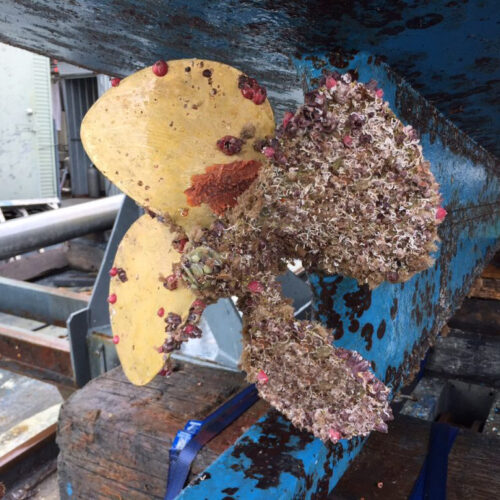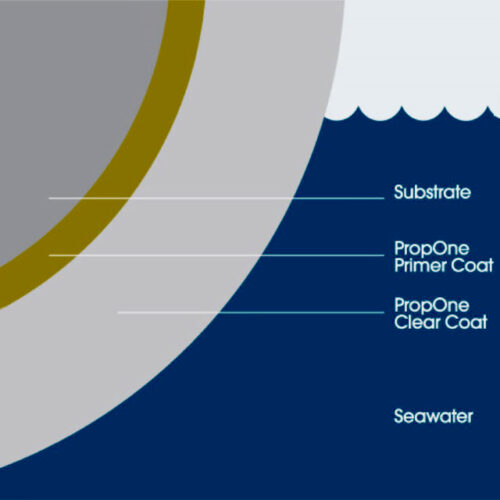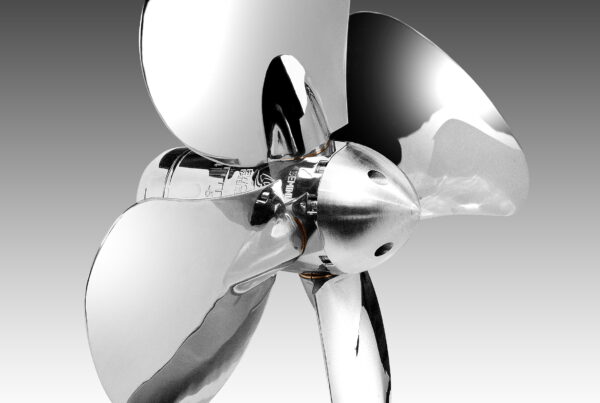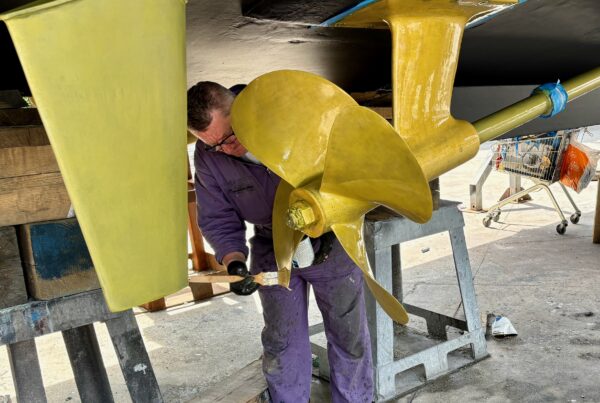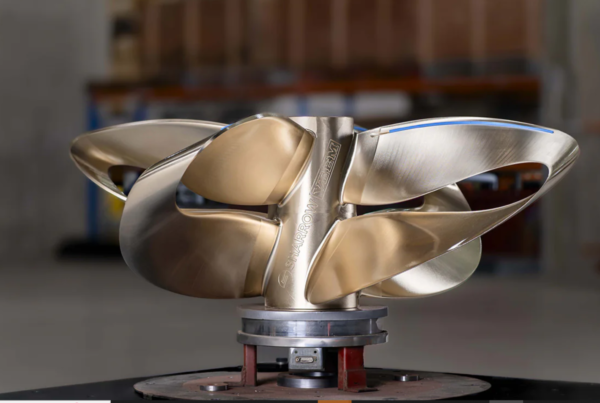- Fouling is the accumulation of marine organisms on underwater surfaces and is an inevitable part of boating life.
- Foul-free vessels get increased speed and less fuel consumption.
- Common solutions to prevent fouling are antifouling and foul release coating treatments.
- Antifouling is the use of biocidal paint coatings, designed to kill marine life that adhere to vessels.
- Foul release coatings work by making surfaces too slippery for marine life to attach themselves and are safe for the marine environment.
- PropOne is a foul release coating specifically designed for propellers and running gear as an alternative to propeller antifoul.
The left two propeller blades have been coated with PropOne, a foul release propeller coating; the right two propeller blades have had no treatment.
If you own a boat then you know that fouling, i.e., the accumulation of marine organisms on underwater surfaces, is an inevitable part of boating life. The rough surface that fouling creates has adverse effects on the performance of a vessel in terms of its speed, maneuverability, and fuel efficiency. Even low levels of fouling on propeller surfaces are shown to cause efficiency losses of 20% and with high levels of fouling causing up to a 70% decrease in efficiency!
From the start of the 20th century the marine industry has since relied on the use of biocidal antifouling paint coatings, designed to kill any marine life settling on vessels’ underwater surfaces.These used toxic heavy metal salts of lead and mercury as well as copper oxide. These were supeseded by the introduction of Tributyltin based antifouling paints in the 1950’s. While these extremely efficient biocides could all but prevent vessel fouling, they were found to have lethal and wide-ranging effects on the entire marine environment; their use is now banned worldwide. Modern biocidal antifouling coatings are designed to slowly release biocides contained within the paint via erosion or polishing away of the coating. This limited coating lifetime, thus necessitates regular re-application.
”Even low levels of fouling on propeller surfaces are shown to cause efficiency losses of 20%. High levels can cause a 70% decrease in efficiency!"
When used as a propeller and running gear coating, the service lifetime of antifouling paint is even shorter due to the increased surface velocity rapidly polishing and/or eroding all the paint from the propeller surface. Increasing awareness and knowledge on the negative effects of these biocides on the marine environment combined with the performance limitations of antifouling paint in this application area have led to an effort to find an alternative.
The breakthrough use of foul release coating technology is quickly replacing the use of antifouling coatings boat props. These low surface energy coatings are primarily formulated with a silicone polymer that is flexible, strongly adhering to its substrate and gives the coating a slick surface when immersed in water. The inherently low surface energy properties prevents organisms strongly sticking to the surface of propellers and fast-moving components permanently immersed in water.
PropOne, a two-coat propeller paint scheme composed of a primer coat and foul release clear coating
Fouling organisms may still settle on and adhere loosely to underwater surfaces coated with a foul release coating. However, they are easily detached as a result of water flowing over the coated surfaces as the vessel travels through the water at regular speed. Similarly, they can easily be detached when a diver gives the prop surface a light brush with a gloved hand or scraper.
When properly formulated foul release coatings like PropOne do not prevent marine growth by chemically poisoning the environment, rather, marine life is kept at bay purely by the physical means of the low energy, slippery surface created by the clear silicone topcoat.
This gives foul release coatings multiple advantages over biocidal antifouling when applied to these areas:
